#Happy bi visibility day For me specifically
Explore tagged Tumblr posts
Text
Also, before I forget. Happy bi visibility day
Especially to my favorite fictional loser, Edward Nigma.


#riddler#edward nygma#edward nigma#the riddler#batman#gotham rogues#green bastard man#it feels like as if ram v personally waled up to me and slapped me in the face with this#everyone say “ thank you Ram V”#i am still not over this#someone get a writer who is brave enough to mention this again#Happy bi visibility day For me specifically
31 notes
·
View notes
Text


HAPPY THESE 3 CANNOT STAND A SINGLE DAY WITHOUT BEING WITH EACH OTHER
IG story (tiialuostarinen) | 9.23.24
#eetu luostarinen#niko mikkola#anton lundell#florida panthers#2425#TIIA. TIIA PLEASE YOURE GONNA KILL ME.#PLEASE. PLEASEEEE.#SHE ALWAYS PROVIDES CONTENT BUT AT WHAT COST I ASK#AT WHAT COST#NO DO NOT ASK ME HOW I FEEL RIGHT NOW#IM GNAWING ON AN IRON POLE#fuckin around on the bay again GOD#im not strong enough FOR THIS#happy bi day of visibility TO ME SPECIFICALLY#YOU WILL SEE ME. I AM BI. FUCK.
10 notes
·
View notes
Text
Cosplay the Classics: Nazimova in Salomé (1922)—Part 2

My cosplay of Nazimova as Salomé
As the studio system emerged in the American film industry at the start of the 1920s, many of the biggest stars in Hollywood chose independence. Alla Nazimova, an import from the stage, was one of them. In 1922, she made a series of professional and creative decisions that would completely change the trajectory of her career.
In part one of CtC: Nazimova in Salomé, I described how Nazimova’s independent productions were shaped in response to trends and ideas surrounding young/independent womanhood in America after World War I and the influenza pandemic. Here in part two, I’ll fit these productions, A Doll’s House and Salomé, into the broader context of the big-money business of film becoming legitimate in America.
While the full essay and photo set are available below the jump, you may find it easier to read (formatting-wise) on the wordpress site. Either way, I hope you enjoy the read! Oh and Happy Bi Visibility Day to all those who celebrate!

My cosplay of Nazimova as Salomé
Artists United? Allied Artists and the Release of Salomé
When Nazimova made her screen debut in War Brides (1916), the American film industry was undergoing a series of formative changes. Southern California became the center of professional filmmaking in the US—fleeing New Jersey (where War Brides was filmed) largely because of Thomas Edison’s attempts to monopolize the business. Preferences of audiences and exhibitors shifted away from one and two-reel films and towards feature-length films. The Star System emerged in full force. Nazimova soon relocated to Hollywood, signed a contract with Metro, and reaped the benefits of this boom period for American film artists.
The focus on feature-film production and the marketing of films based on the reputations of specific filmmakers or stars required a greater initial outlay of resources—time, money, and labor. But, it also paid dividends—the industry quickly grew into a big-money business. The underlying implication of that is that a larger share of the profits were shifted from the people doing the creating (artists and technicians) and towards other figures (capitalists). In practice, this also meant film companies would become eligible for listing on the stock exchange and could secure funding from banks and financial institutions, both of which were rare or impossible before the mid-1920s. The major players on the business end of production, distribution, and exhibition, therefore, wanted to consolidate their power and reduce the power and influence of the filmmakers.
To illustrate how momentous this handful of years was in the history of the US film industry, allow me to highlight a few key events. Will Hayes’ office was set up in 1922 to make official Hollywood’s commitment to self-censorship. Eastman Kodak introduced 16 mm film in 1923, a move which, while making filmmaking more accessible and affordable, also widened and formalized the division between the professional industry and amateur filmmaking. Dudley Murphy’s “visual symphony” Danse Macabre[1] was released in 1922—considered America’s first avant-garde film. Nazimova’s Salomé was considered America’s first art film from its initial release in 1923. That these labels were deemed relevant in this period illustrates the line being drawn between those films and film as a conventional, commercial product. The concept of art cinemas in the US was first proposed in 1922 spurring on the Little Cinema movement later in the decade.

from Danse Macabre

from Salomé
As any industry matures, both the roles within it and its output become more starkly delineated. That is to say that, as the US industry began differentiating between art/avant-garde/experimental film and commercial film, the jobs within professional filmmaking also became more firmly defined. Filmmaking has always been a collaborative art, but in the period prior to the 1920s, it was common for people in film to do a little of everything. As a result, what sparse credits made it onto the final film didn’t necessarily reflect all of the work that was done. To illustrate this using Nazimova,[2] at Metro, she had her own production unit under the Metro umbrella. While her films were “Nazimova Productions,” she didn’t have full creative control of her films. However, Nazimova did choose her own projects, develop said projects, and contribute to their writing, directing, and editing. When those films were released, aside from the “Nazimova Productions” banner, her only credit would usually be for her acting. Despite that impressive level of creative power, the studio still had the ultimate say on whether a film got made, and how it would be released. As studios grew and tightened control of their productions, this looser filmmaking style became much less common.
The structure of the industry at this time was roughly tripartite—production, distribution, and exhibition. Generally speaking, the way studio-made films traveled from studio to theatre—before full vertical integration—was that the production company would make available a slate of films of different scales. (Bigger productions with bigger names attached would have a special designation and come with higher rental fees.) Famous Players-Lasky was the biggest production house at the time, though other studios, like Metro, were quickly catching up. Distribution companies would then place this slate of films on regional exchanges, centered in the biggest cities in a given region. Exhibitors (this could be owners of chains like Loew’s in the Midwest and Northeast, the Saengers around the gulf coast, or individual theatre owners) could then rent films through their local exchanges. (This was an ever-shifting industry, so this process was not true for every single film. This is only meant as a quick overview of the system.) As the 1920s wore on, exhibitors began entering the production arena and producers further merged with distribution companies and exhibition chains. Merger-mania was the rule of the day.

My cosplay of Nazimova as Salomé
As merger upon merger took place and a handful of businessmen tried to monopolize the industry, American filmmakers responded by championing the artistic legitimacy of filmmaking in the US. Leading this charge were the very filmmakers on whose backs the big business of film had been built. As noted in Tino T. Balio’s expansive history of United Artists, The Company Built by the Stars:
…Richard A. Rowland, president of Metro Pictures, proclaimed that ‘motion pictures must cease to be a game and become a business.’ What he wanted was to supplant the star system, which forced companies to compete for big names and pay out-of-this-world salaries for their services. Metro, he said, would thenceforth decline from ‘competitive bidding for billion-dollar stars’ and devote its energies to making big pictures based on ‘play value and excellence of production.’”
It’s notable for us that these ideas were espoused by Rowland, head of the studio where Nazimova was currently one of those “billion-dollar stars.” (“Billion-dollar” is obviously a massive overstatement.) It was a precarious time for any filmmaker who cared about the quality and artistry of their work. It was this environment that birthed United Artists, a new production company built around the prestige and reputation of its filmmakers, Douglas Fairbanks, Mary Pickford, Charlie Chaplin, and D.W. Griffith. As the statement announcing the formation of UA detailed:
“We also think that this step is positively and absolutely necessary to protect the great motion picture public from threatening combinations and trusts that would force upon them mediocre productions and machine-made entertainment.”
It’s an accurate assessment of industry trends at the time. If the desired product is a high-quality feature-length film, production is necessarily more expensive. As the UA statement intimates, monopolizing the entire industry and sacrificing quality for quantity to fill the exchanges and theatrical bills was the studio heads’ solution to rising costs. Not a great signal for filmmaking as art in America.
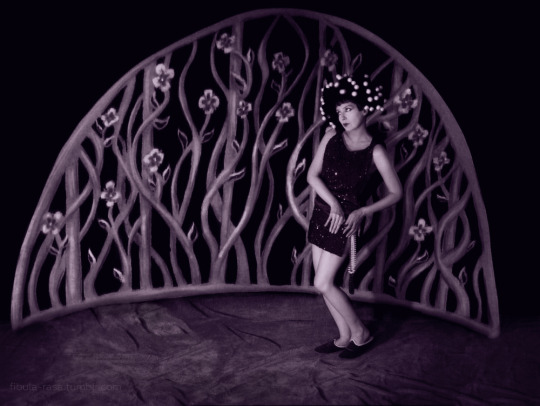
My cosplay of Nazimova as Salomé
So, Nazimova was in good company when she chose to go independent, believing in film as art and that American moviegoers deserved better than derivative, studio-conceived films. Some of the other artists who went independent included George Fitzmaurice (one of the most revered directors of the silent era, though most of his films are now sadly lost), Charles Ray, Max Linder, Norma Talmadge (in alliance with Sam Goldwyn), and Ferdinand Pinney Earle (whose massive mostly-lost artistic experiment Omar Khayyam, I profiled in LBnF). If these filmmakers shared the motivation of UA to create higher-calibre productions, where would the money come from? For Nazimova, the answer was her own bank account.
In 1922, Nazimova’s final film for Metro, Camille (1921), was still circulating widely due to the rising popularity of her co-star, Rudolph Valentino, after the release of Four Horsemen of the Apocalypse (1921) and The Sheik (1921). While Nazimova had the funds to complete A Doll’s House and Salomé, there was no sure bet for the films’ releases. Nazimova’s initial concept for her independent productions was the “repertoire” film. This scheme would have seen A Doll’s House released as a shorter film with Salomé as a feature and the two could be rented as a package by exhibitors. It was a creative response to growing tensions between producers and exhibitors over a practice called block booking. Block booking was a strategy studios employed to leverage the Star System to its fullest. They would take the most in-demand films associated with the biggest drawing stars and only make them available in a package deal with productions that were perceived as less marketable. Nazimova was aware that her films at Metro had been rented this way (as the special feature). It’s not completely clear from my research if the decision to release Salomé and A Doll’s House as two features was creative, practical, or a combination of the two. The “repertoire” concept may not have gone according to plan, but it was an early indication that Nazimova was well-informed of the nuances of distribution and exhibition.
Nazimova’s need for proper distribution was met by United Artists’ distribution subsidiary, Allied Artists. United Artists’ first few years were a struggle. Fairbanks, Pickford, and Griffith[3] needed significant time and money to finish the high-quality productions that they promised and Allied was their solution. This distribution arm would release the work of other independent talent using the same exchanges as UA, but under a different banner. Though Allied used UA’s exchanges for distribution, the subsidiary had its own staff. Allied having different branding would also protect the prestige of the UA name. (An unkind, but not entirely inaccurate summary: the money your work brings in is good enough for us, but your work is not.) Allied would have a full release slate to generate the revenue that UA needed to remain in operation.
Nazimova was one of the filmmakers who signed a distribution deal with Allied and had reason to regret it—though she and Charles Bryant didn’t openly rag on UA/Allied.[4] Notably, Mack Sennett had arranged the release of Suzanna (1923) through Allied and was vocal about the company bungling its release. Differences over distribution and exhibition would also lead to Griffith’s exit from the company and a major rift between Chaplin and Pickford-Fairbanks. After 1923, Allied reduced its operation, at least in part because of the bad reputation they were garnering with other filmmakers. Despite numerous independents losing money on productions released through Allied, by 1923, Allied had netted UA 51 million dollars in revenue!
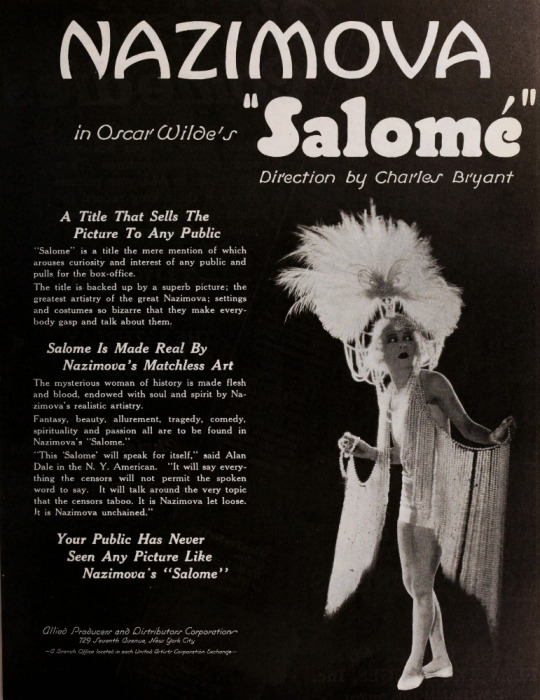
Trade ad for Salomé from Motion Picture News, 10 March 1923
The questionable deals that these independent filmmakers received with Allied are often mentioned in discourse about the period, but very, very rarely does anyone offer details of what Allied’s inadequate distribution looked like. Using the information available to me via Lantern, I collected and analyzed data regarding the release and exhibition of Nazimova’s final two Metro films and both of her Allied films.[5] Looking at the trade publications Exhibitor’s Trade Review, Moving Picture World, Motion Picture News, and Exhibitors Herald, I categorized every item I found about the release or exhibition of Billions (1920),[6] Camille, A Doll’s House, and Salomé. The “release” items are primarily advertisements, reviews, and news items about release dates or pre-release screenings. The number of these items for all four films were comparable.
The items in the “exhibition” category, however, reveal a marked difference between the Metro and Allied releases. This category includes items like first-run theatre listings, exhibitor feedback, and advertising advice for theatre owners. Only counting exhibition items from the first two years (24 months) from the initial release of each film, Billions and Camille had twice as many items as A Doll’s House and Salomé!
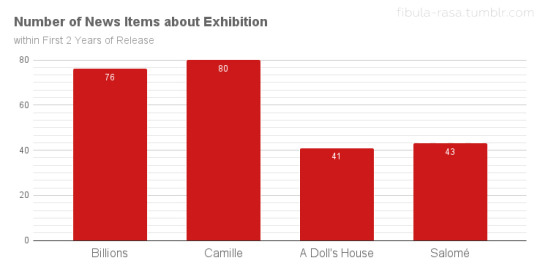
While this isn’t necessarily hard data on how many theatres ran each film, it is a rough indicator of how well the films circulated. This data suggests that neither A Doll’s House or Salomé had distribution comparable to the Metro films. In order to compensate for the Rudy factor—Valentino’s major rise to stardom in 1921—which could have affected Camille’s numbers in a big way, I included Billions as well. Billions was sold as a special (a bigger production with premium rental fees) on Nazimova’s name alone. It was not especially well received. Exhibitors/theatre owners had mixed feelings on the film because Nazimova’s previous film, Madame Peacock (1920), had underperformed. Many exhibitors viewed Billions as an improvement, though it still did not meet their perception of Nazimova’s standard of quality. Despite that, Billions had 76 exhibition-related items across its first 24 months of availability to Camille’s 80.
To get a little deeper into this data, I wanted to see how the feedback from exhibitors and theatre owners compared. I broke down the exhibitor feedback for each film as positive, middling, or negative based on how the exhibitors assessed audience response and/or box office receipts. (I discounted feedback that only reflected theatre owners’ own personal assessment of the films without mention of their patrons or receipts.) Positive feedback could be good reception and/or good receipts, middling suggests only average business and no noteworthy reception, and negative indicates poor response and/or poor ticket sales. Since there are so many more items about Camille and Billions than A Doll’s House and Salomé, I compared ratios as an indicator of exhibitor satisfaction. The results were truly surprising.
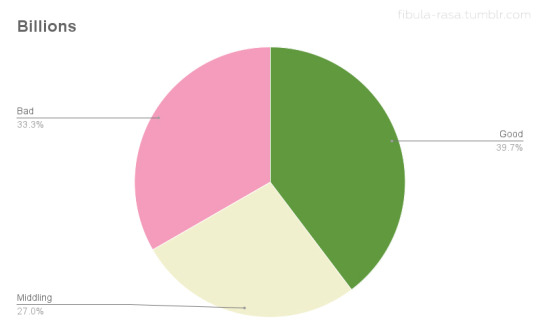

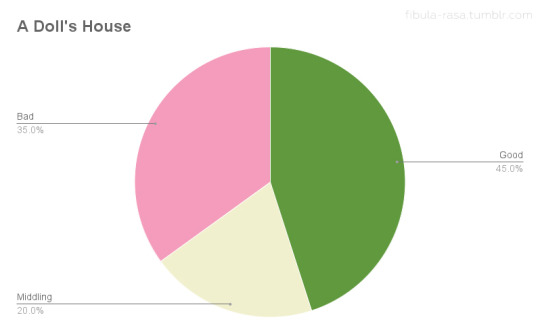
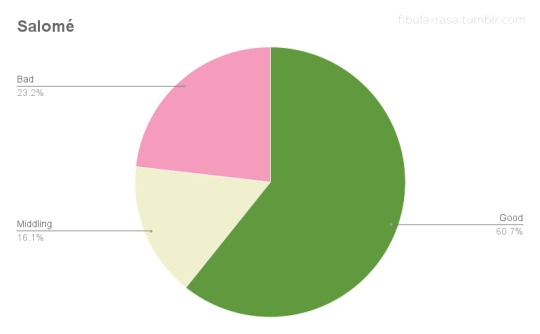
Theatre owners who rented Salomé may have been in significantly smaller numbers than those who ran Camille, but their satisfaction with ticket sales and audience feedback was roughly equivalent. (Though slightly more positive for Salomé!) The numbers for Billions line up with the qualitative assessment I summarized above, displaying a roughly equal 3-way split. A Doll’s House was the most divisive with the highest proportion of negative feedback of the four films, yet with a higher proportion of positive feedback than Billions.
Taking all of this into account, it’s clear that Salomé did not flop because it was too artsy or esoteric for the American moviegoing public. Such assumptions are obviously not very thoughtful or informed by reliable data.[7] A more historically sound reading is that, as professional filmmaking matured into a “legitimate” industry in the US, the various arms of the business were rigidly formed to fit conventional output. The conservatism that this engendered made the American industry ill-equipped at marketing anything too unconventional or experimental. While Hollywood insiders were lamenting European filmmakers artistically outdoing Americans—especially following the US release of The Cabinet of Dr. Caligari (1920)—very few people with the power to shape the industry did anything to support experimentation. Given this environment, Salomé could only have been produced independently, but the quickly ossifying distribution and promotional systems didn’t have the range to give it a proper release. Two films contemporary to Salomé, Beggar on Horseback (1925) and The Old Swimmin’ Hole (1921) offer further evidence of the industry’s limitations.
The Old Swimmin’ Hole is a feature-length production by Charles Ray, experimental in that it uses no intertitles. The story is simple and familiar with Ray playing the Huck-Finn-type character he was well known for. Ray’s experiment was not an expensive one and the film was successful. However, decision makers at First National, the film’s distributors, felt that The Old Swimmin’ Hole was simply too complex for small-town Americans to comprehend and it wasn’t released outside of cities. To put it plainly, the distributor’s unfounded concept of ignorant yokels meant that a film about country living was largely inaccessible to anyone actually living in the country. Though the film was well received and turned a profit, this distribution decision likely limited its audience as well as possible revenue from small-town exhibition.

Stills from The Old Swimmin’ Hole from Motion Picture Magazine, April 1921
Beggar on Horseback was produced by one of the biggest studios in Hollywood, Famous Players-Lasky, and distributed by Paramount. Starring comedian Edward Everett Horton, Beggar was an expressionist comedy based on a popular play. The film had a popular star, popular source material, and was made and released by a major company, but Beggar was apparently too unconventional for that major company to adequately market it. (Unfortunately, only a few minutes of the film survive, so we can’t fully reassess it unless more is found/identified!)
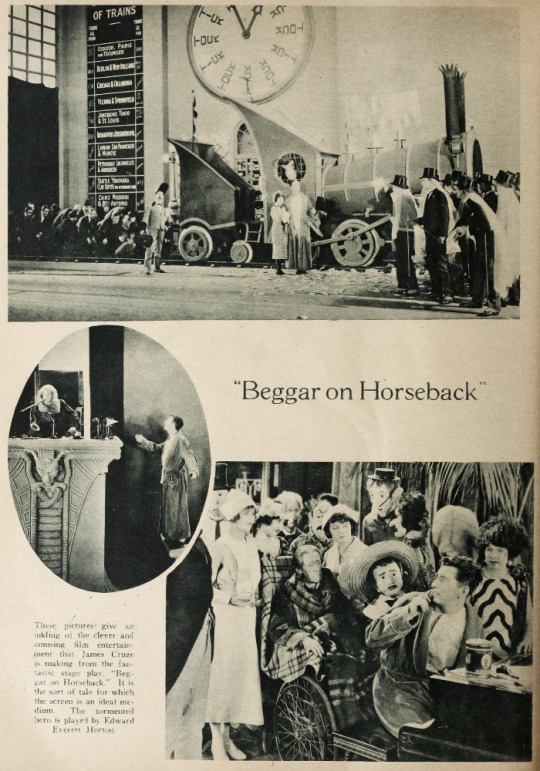
Stills from Beggar on Horseback from Picture-Play Magazine, August 1925
With all these complicating factors at play, how might have Salomé found its audience in 1922-3? Nazimova and Charles Bryant had innovative ideas for the film’s release that might have done the trick, if they had been able to act on them. Nazimova and Sam Zimbalist had finished cutting Salomé in late-spring 1922. Having spent practically all of her money to finish the film, and following A Doll’s House’s disappointing results, Nazimova was eager for Salomé to hit theatres. Though the film was in the can and private preview screenings had been held by Bryant by summer ‘22, Salomé wouldn’t be released until February of 1923. In studio filmmaking, holding a film in extended abeyance wasn’t ideal but it was not disastrous. Studios had significantly more resources and revenue streams than independent producers. If, for example, the release of Billions had been delayed for seven months, Nazimova still had two films on the Metro exchanges (and therefore in theatres) and Camille would have entered production in the meantime. But for Nazimova as an independent producer, this situation was wholly untenable. (In fact, Pickford, Fairbanks, and Griffith were in a similar untenable situation when they founded Allied.)
Initially, Bryant proposed roadshowing Salomé. Roadshowing is a release strategy for notable film productions where a film is toured around major cities, often with in-person engagements by stars, writers, and/or directors. Nazimova expanded the idea of touring with Salomé not simply as a roadshow, but paired with a short play in which she would star. Double the Alla, double the fun. As far as I can tell, there isn’t publicly available information about why Salomé wasn’t roadshowed. However, we do know that Griffith, as the only non-performer in UA, wanted to utilize different approaches for the release of his films—like roadshowing—and it became one of the major points of disagreement with his fellow UA decision makers. That could be taken as an indication that something similar might have occurred with Nazimova and Allied.
As time dragged on without a release date for Salomé and Nazimova returned to theatrical work—openly admitting to audiences that she was broke—Bryant took matters into his own hands. At the end of December 1922, Bryant negotiated with the owner of the Criterion Theatre in New York City for Salomé to run on New Year’s as a special presentation. In two days, Salomé grossed $2,630, setting records for the theatre. Adjusted for inflation, that’s $48,988.96. It was successful enough that the owner of the Criterion opted to hold the film over. This bold move must have lit a fire under Allied’s tuckuses, as Salomé finally had its first-run release a little over a month later.
In the 1920s, the first-run booking of a film was a crucial part of its further success. Concurrent nationwide release of films wasn’t the norm yet, and if a film was a big production, getting booked at high-capacity motion picture houses in major cities was a necessity. These big city releases would, in theory, generate interest in the film with exhibitors across the country and internationally. Basically, if you spent a lot on a movie but couldn’t land a first-run release, you weren’t likely to turn a profit or even break even. Salomé had a handful of first-run bookings and local reviewers from those cities believed the film would succeed. A reviewer from the Boston Transcript in February 1923 wrote:
“…this newest Salome is something far better than a photographed play. Considered both as picture acting, and as an interesting experiment in design, “Salome” is a notable production. It will have a far and wide reaching influence on future films in this country.”
But, as I mentioned, only a handful of first-run theatres played Salomé, and, taken collectively, the notices I analyzed from contemporary trades imply that it didn’t gain traction once it was made available beyond its initial run.
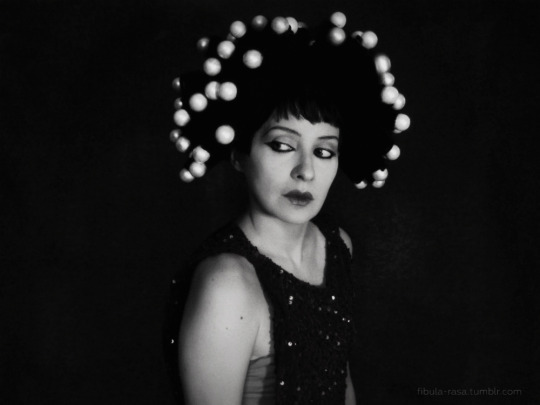
My cosplay of Nazimova as Salomé
During this regrettably short theatrical run, exhibitors and reviewers from trade publications advised that Salomé was a unique film that called for unique promotion. The overall assumption was that theatre owners knew their patrons and recognised whether out-of-the-ordinary movies were popular with them. Rather than purely judging a film’s quality, exhibitors and trade reviewers had concerns specific to exhibition when providing feedback. These concerns cannot be overlooked if you want to understand their assessments. For example, exhibitor feedback was very often informed by how high the rental fees were for a film, even if exhibitors don’t directly mention said fees. That is to say, a mediocre film might be rated highly if the rental fees were modest (and if block booking wasn’t an issue). Reviewers in the early 1920s, both for popular magazines and trade publications, were already accustomed to the formulaic nature of most studio output. Their reviews commonly expressed fatigue with studio films’ lack of originality. And, perhaps surprisingly, this sentiment was shared among theatre owners as well—particularly when a run-of-the-mill film was sold to them as anything other than a “programmer” (a precursor to B-movies).
What I have learned, not just by analyzing feedback for Salomé, but also for all of the films in my LBnF series, is that when a 1920s reviewer calls out bizarreness in a film, it’s not always a negative quality, even when the review isn’t positive. In the case of reviews written for exhibitors/theatre owners, focussing on what makes a movie different is purely pragmatic. It guides how exhibitors might market films to patrons and helps exhibitors judge if a film would be suitable for their audiences. And, from that same research, I’ve found significant indications there were numerous markets throughout the US that were hungry for novelty—contrary to what studio apparatchiks wanted to admit. So, pointing out Salomé’s bizarreness was a recommendation for those markets to consider renting it as much as it was a warning against renting for theatre owners who only had success with more conventional films.

Cover of the Campaign Book for Salomé reproduced in Exhibitors Herald, 9 February 1924
In the case of Salomé, reviews and feedback upon its release focused on two major points:
The film isn’t “adult” in nature. Well-known productions of Strauss’ opera and the 1918 Theda Bara film of the same name led to a presumption of salaciousness. (I talked a bit about that in Part One!)
The film deserves/requires a build up as an artistic event film.
Nazimova’s company helped exhibitors with the latter point in a few ways. The company provided Aubrey Beardsley inspired art posters conceived by Natacha Rambova and executed by Eugene Gise. They printed a book to guide promotion of an artistic spectacle. (So far, I haven’t been able to find a physical or digital copy, so I can’t assess how good the advice was!) Salomé was also distributed with an official musical score, apparently written for a full orchestra.
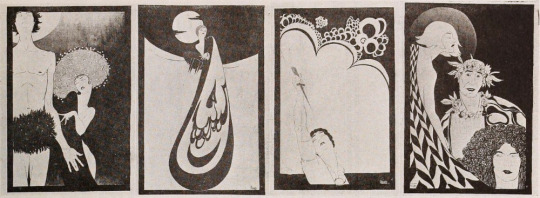
Art Posters designed by Rambova and painted by Gise as reproduced in Exhibitor’s Trade Review, 10 February 1923
The exhibitors who ran Salomé—and put at least some of this advice into practice—were satisfied with the business it did. By these accounts, the American moviegoing public was attracted by the novelty of Salomé, but what chance were they given to see it?
While this evidence of Allied’s poor distribution work may be circumstantial, it certainly complicates the narratives that Salomé was an unqualified flop or that average Americans weren’t (or aren’t) receptive to artistic experimentation. Given that Nazimova was not the only independent filmmaker who suffered from Allied’s inept distribution, it does seem like the underwhelming business Salomé did was due more to a poor choice of business partners than to any quality of the film or of American moviegoers. That said, with the increasing monopolization of the industry, Nazimova did not have a wealth of options.
Though Salomé was made and released at an tumultuous period for the US film industry, it did eventually find its audience through circulation in art cinemas. As the gap between experimental/avant-garde film widened in the US and the professional industry became less and less tolerant of departures from convention, Americans concerned with film as an art form rallied around amateur filmmaking clubs and art cinemas began popping up in cities by the middle of the decade. Salomé played in these theatres even after the advent of sound—occasionally even today. This is likely the key reason that Salomé survives and we’ve been able to continue to enjoy and reevaluate it one hundred years later.
Salomé is a significant film made at a significant moment in American film history. Nazimova took a major risk in going independent and personally funding two artistic projects. These films were founded on the beliefs that American moviegoers wanted art made by human beings with unique imaginations, feelings, sensibilities and that there was an audience for more than derivative, “machine-made” film. In my opinion, through close analysis of the circumstances of Salomé‘s release, we can see that Nazimova was likely correct, but didn’t get a genuine chance to prove it in her lifetime. Additionally, it’s important to note that Nazimova’s risks did not “ruin” her as is occasionally said. The state of her finances were more greatly affected in the 1920s by her fake husband’s habit of spending her money and by getting swindled by a pair of con artists over her estate, The Garden of Alla. Soldiering on, Nazimova continued to work in both theatre and film for the rest of her life and found more stability with the partner she would meet at the end of the 1920s, Glesca Marshall.
——— ——— ———
Once I finished this “Cosplay the Classics” entry, I realized that it would way too much for me to include a section on another relevant topic to Salomé: Orientalism in Hollywood. But, I feel that the topic is too important to just edit that writing out. Look out for a shorter “postscript” entry soon!
——— ——— ———
☕Appreciate my work? Buy me a coffee! ☕
——— ——— ———
Footnotes:
[1] Danse Macabre is also thought to be a major influence on Walt Disney animating to music, as seen in “Silly Symphonies” and later Fantasia (1940) and Disney’s other musical anthology features. It was also in this period that Disney fled from his debtors in the Midwest to California with his first “Alice” movie. However, the wide-ranging effects of Disney’s business practices were not felt until much later, so that’s another story for another time!
[2] Nazimova was one of a handful of women in Hollywood at the time who held significant creative power. June Mathis and Natacha Rambova, both of whom Nazimova regularly worked with, Mary Pickford and her regular tag-team partner Frances Marion are among some of the others.
[3] Chaplin wouldn’t produce a film for UA until 1923’s A Woman of Paris, as he was fulfilling a pre-existing contract with another studio.
[4] According to Gavin Lambert’s biography of Nazimova (which I discussed as a largely unreliable source in Part One), Robert Florey supposedly advised Nazimova against signing with them, citing Max Linder and Charles Ray as artists who had been “ruined” by their deals. However, the timeline does not quite match up. Though Florey did visit the set of Salomé, Nazimova had already signed the Allied deal by then and Ray had not finished The Courtship of Miles Standish (1923) when Salomé was in production. In fact, there was almost a year and a half between the completion of Salomé and the release of Standish. Whether this was a lapse of memory by Florey or misreporting by Lambert, I can’t be sure.
[5] Originally, I wanted to include Madonna of the Streets (1924) in my comparisons but, at the moment, Lantern has gaps in their Moving Picture World archive for 1924-5. I didn’t want to draw conclusions from incomplete data.
[6] Billions was also a Rambova-Nazimova collaboration. Rambova designed a fantasy sequence for the film.
[7] A mindset that’s still common among commercial media outlets today unfortunately. I could rant and rant about “content” and “content creation” all day but that’s another story for another time.
——— ——— ———
Bibliography/Further Reading
(This isn’t an exhaustive list, but covers what’s most relevant to the essay above!)
Lost, but Not Forgotten: A Doll’s House (1922)
“Nazimova in Repertoire” in Motion Picture News, 29 October 1921
“Alla Nazimova Plans for Her New Pictures” in Moving Picture World, 29 October 1921
“Nazimova Abandons Dual Program for Latest Film” in Exhibitors Herald, 24 December 1921
“Plays and Players”in Photoplay, February 1922
“PICTORIAL SECTION” in Exhibitors Herald, 4 February 1922
“New Nazimova Film May Be Roadshowed“ in Exhibitors Herald, 15 April 1922
“Newspaper Opinions” in The Film Daily, 3 January 1923
“Splendid Production Values But No Kick in Nazimova’s ‘Salome’” in The Film Daily, 7 January 1923
“Claims “Salome” Hit New Mark at N. Y. Criterion” in Exhibitors Herald, 27 January 1923
“Salome” in Exhibitors Trade Review, 20 January 1923
“Nazimova in SALOME” in Exhibitors Herald, 27 January 1923
“Nazimova Appeals To Exhibitors In Behalf of ‘Salome’” in Exhibitor’s Trade Review, 27 January 1923
“Novelty Features Paper and Ads for ‘Salome’” in Exhibitor’s Trade Review, 10 February 1923
“SALOME’ —Class AA” from Screen Opinions, 15 February 1923
Nazimova: A Biography by Gavin Lambert (Note: I do not recommend this without caveat even though it’s the only monograph biography of Nazimova. Lambert did a commendable amount of research but his presentation of that research is ruined by misrepresentations, factual errors, and a general tendency to make unfounded assumptions about Nazimova’s motivations and personal feelings.)
Lovers of Cinema: The First American Avant-Garde 1919-1945 ed. Jan-Christopher Horak (most notably, “The First American Avant-Garde 1919-1945” by Horak, “The Limits of Experimentation in Hollywood” by Kristin Thompson, and “Startling Angles: Amateur Film and the Early Avant-Garde” by Patricia R. Zimmermann)
United Artists: The Company Built by the Stars, Vol. 1 1919-1950 by Tino Balio
#1920s#1922#Salomé#salome#nazimova#alla nazimova#film history#cosplay#queer film#silent era#classic movies#film#avant garde#experimental film#cinema#queer film history#silent cinema#1923#classic cinema#american film#women filmmakers#women in film#silent film#classic film#silent movies#bisexual visibility#cosplayers#natacha rambova#united artists#Metro
36 notes
·
View notes
Text
My top 5 hairstyles from The Owl House that I am very normal about.
Luz, specifically her in the season 2 finale, and post time-skip.
While in season three Luz spends a lot of time wearing a hat or in Halloween costume, which means we don’t get to see her hair, I still fucking LOVE what the animators did to her hair late in season two/ end of season three, specifically, the little mini-pony tail she’s rocking when she rescues Amity. It’s got a very 1700’s short Queue/ gentlemen’s club-tail pirate vibe to it, giving the whole scene a swashbuckling and romantic vibe as Luz literally climes up onto the balcony of her love interest’s boudoir to rescue her from her evil and overbearing mother, It’s wonderfully practical, romantic, tomboy-ish and playful, and seems like a direct fuck you to Bellos who also wears his hair in a similar tied-back style.
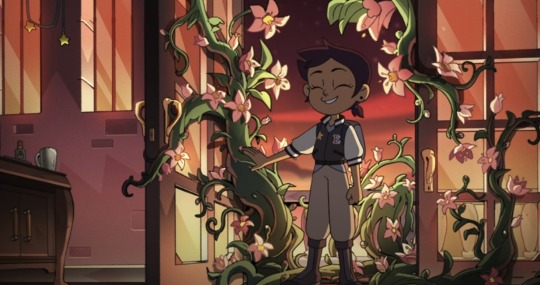
look at those pants tucked into tall boots and tell me they weren't thinking pirate.
It hints at a volume and springiness of hair that make you realise that the animators and design team actually considered Luz’s Afro-Latina roots before promptly forgetting that again for most of season 3, only to bring it back for the post time-skip Luz. 9/10
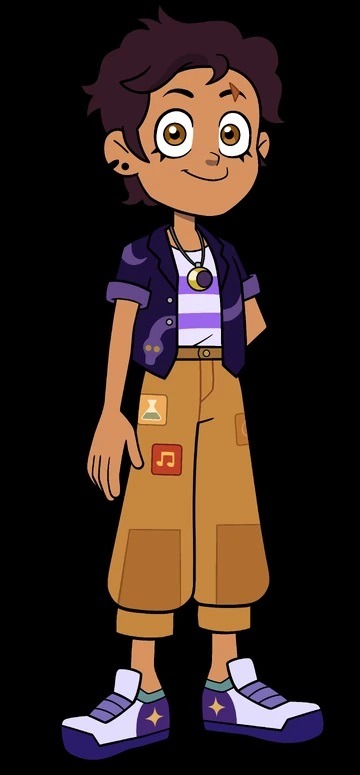
Amity, specifically the change in hair colour.
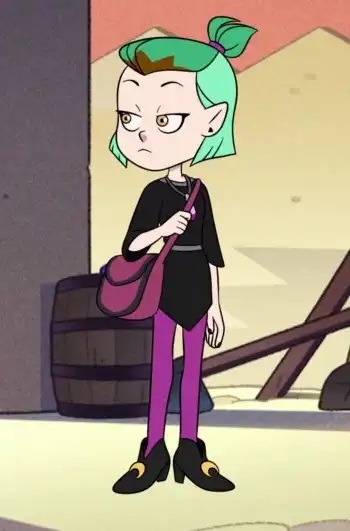
This is just great character design: using the character’s visual design to communicate information about her to the audience: her hair is neat, prim, proper… restraining, very tied back, not at all free, and not only is it clearly a dye job, but a bad one, with the visible change in colour at the roots. You can tell from her hair, she is not happy with who she is at that point in her life. She’s had her hair done to blend in with the twins and her mother, be a part of a matched set, and you can see how she doesn’t care for it or she would have done something about those roots: bits of the real her, bits of her father’s influence, bleed through without Amity even realising. And then… BLAM.
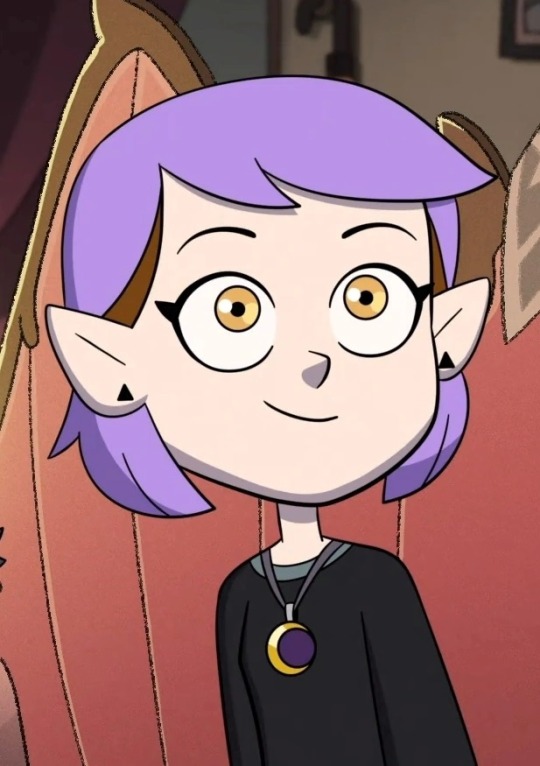
Change to a purple do, the colour of abominations reflecting her talents and passions, which incorporates hints of her natural brown hair deliberately and thoughtfully. It’s even called out by the twins that her mom would hate it. It’s also a very similar colour to the purple on the Bi pride flag, and seconds after Luz see’s her with it for the first time, Amity kisses Luz for the first time. New hair, new her. It’s a colour that pairs well with the blues and purples Luz typically wears, and close to the shade you would get if you colour-averaged the Dominican Republics’ flag (thought that’s probably just a coincidence). It’s Amity rejecting who her mother wants her to be, and embracing the person Luz sees her as, and I Love it. 9.5/10
Principle Bump
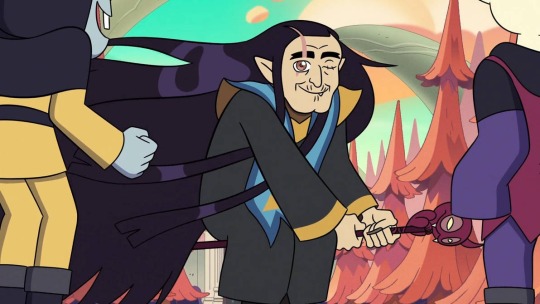
You mean to tell be that Pallisman was hiding yards upon yards of the most beautiful silky flowing hair I’ve ever seen in a cartoon? Sir, you can not just drop that much swag mid-way thought season two, and not in the presence of minors, it’s just too sexy. 10/10.
And speaking of too damn sexy… Eda Cawthorne, the Owl Lady.

Oh my god yes. Just yes. Chef’s kiss perfection. Hair so voluminous it has dominates the outline of the character creating a distinct silhouette even at distance, hair that bobs and move in the action sequences with it’s own weight an gravity. I’m amazed she can walk, let alone strut, given that her centre of gravity must be a foot behind her head. Hair so voluminous you struggle to hide it when you’re in disguise, and so magical it has it’s own pocket dimension for storage and/or is just so big you can keep stuff in there like a handbag. By the Titan, drown me in your hair Owl Lady.
Special shout out to the pre-curse Eda hair as well: Flaming red, with her golden eyes, her narrow, pointed face and (even for a witch) huge pointed ears and the two hanging bits at the front that look like fox-tails? You just know Raine took one look at this and the carved their Fox Pallisman the very next day (and while it’s cannon that carving Owlbert was an attempt by Eda to reclaim some positive association with owls in her mind post-curse, the fact Raine looks like an owl with their big round glasses and little round face must have been on Eda’s mind: it’s my headcanon they carved their Pallisman’s to look like each other.)
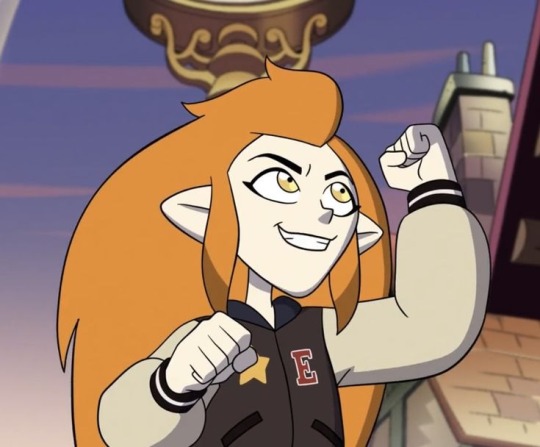
11/10, perfect character design.
And finally, Vee, particularly right at the end of season three.

SHE HAS A BIG MANE OF HAIR TO HIDE HER EARS AND IT LOOKS LIKE AN AXOLOTL’S GILLS! SHE HAS ACTUAL AXOLOTL HAIR AND IT HIDES HER LITTLE EARS! THIS IS THE CUTEST THING I HAVE EVER SEEN JUST LOOK AT THIS LITTLE AXOLOTIL GIRL! 200/10!
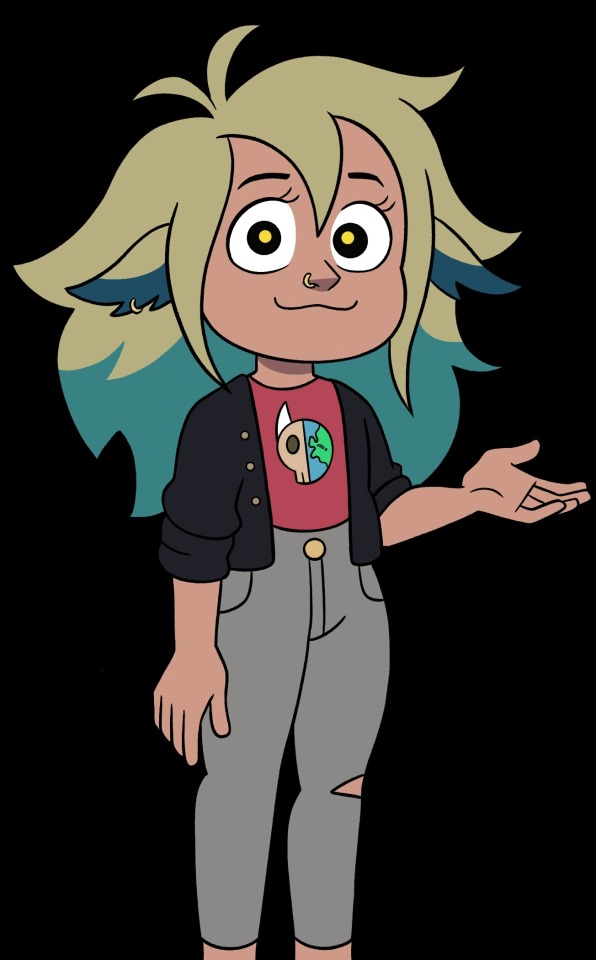
#the owl house#toh#charicter design#hair styles#by Owl house brainrot has finaly taken over#luz noceda#amity blight#Principle Bump#eda the owl lady#eda clawthorne#vee noceda#LOOK AT HER LITTLE EARS!#Honourable mentions to Darius and Terra Snapdragon#but when you replace body parts with abomination goop or plants you are in a different league and its not fair on the others
20 notes
·
View notes
Text
Criminal Minds PRIDE Fic Challenge!
Here we go! First writing challenge ever and I'm even more excited about the theme. During June I ask fic writers to challenge themselves a little bit by writing a piece that is LGBTQ+ inclusive!!! Don't let the topic intimidate you; If you want to participate, but don't know where to start, there are prompts to help. All the fics will be collected in a Masterlist that will be avalible by July 1st.
Note: if you have accessibility issues with this post (or any of my posts!) let me know and I can send you the information in an accessible format.

Prompts and rules are under the cut!
------
These prompts are only ideas to help get you started! You can write any LGBTQ+ centered fic you want! Feel free to modify any of the more specific prompts to your liking.
Prompts:
Character coming out to their friends/family/the team.
Character's found family is more supportive than biological family when they come out.
Characters go to a pride parade/festival/event!
Characters discuss queer coding in media.
Character(s) explains their new, queer relationship to a child.
Character 1's child comes out to them. They go to Character 2 to ask what they wish their parents would have done.
Character 1 is having an identity crisis (gender or sexuality). They go to Character 2 for help.
Character 1 is confident about their identity. Character 2 isn't, so they ask for some advice.
Character 1 takes Character 2 to a gay bar for the first time to act as their wingman/wingwoman/wingperson.
Character 1 is unsure if they're attracted to or envious of Character 2's confidence in their identity.
Character has been dating Morgan, but realizes they're not attracted to men. He isn't sure how he ended up in this situation twice, but it's the perfect opportunity for him to play matchmaker for his ex girlfriends.
Character comes out to the team (or it's just pride month) and Penelope goes a bit overboard with decorations.
For the writers who are intimidated by this topic or unsure if they can write it: write something with GN!reader. It's less intimidating than you think, and it can make someone's day to be able to read a fic they might otherwise not relate to!
Bi and Pan Prompts:
Character 1 has always thought they were straight, but they realize their feelings for their best friend, Character 2, are more than platonic.
Character 1 is in a straight passing relationship and worries about the visibility of their queer identity. Their partner is incredibly supportive in helping them express themselves.
(NSFW) What does Emily really do during a sin to win weekend?
Trans and Nonbinary Prompts:
Character 1 gives Character 2 a gender affirming haircut.
Hotch teaches Character how to shave.
JJ teaches Character how to do make up.
Character finds themselves needing gender affirming clothes. Rossi makes sure they have the best of the best.
(NSFW) Character 1 gifts Character 2 gender affirming lingerie and it gives them quite the confidence boost.
Aro and Ace Prompts:
Character 1 keeps trying to set up Character 2 with people/telling them to find someone to help ease their stress. Character 2 has had enough of it.
Character has a monthly spike in libido and it makes them question their identity. Spencer tries to help with a ramble about science (NSFW add on: and a few other ways).
------
Rules:
The fic can reader insert, OC, character x character, general fic, etc. as long as the character(s) is from Criminal Minds (yes, even the ones I don't write for).
Fics can be any genre and can be platonic or romantic in nature... and yes, this includes smut (I know, I know my brand is ruined. Oh well). You must be 18+ if you are going to submit smut. You all know I love platonic fics very much if not more!
You can write something new or dig up something you've already written! I'm also happy to add on fics that are sent to me after the masterlist is posted.
Tag me in your fic or message me the link. Please list the ship, content warnings, and have a 1-2 sentence summary of your piece! If you have multiple pieces, you can submit a mini masterlist.
Be kind and respectful! Reach out to me if you have any concerns. This blog is a safe space!
------
Thank you to @imagining-in-the-margins for the support and for sending some of the prompts from discord! (and telling me it's safe to tag @foxy-eva for this too)
#criminal minds fanfiction#criminal minds fanfic#criminal minds fluff#criminal minds x gn!reader#spencer reid fanfiction#spencer reid fanfic#spencer reid smut#spencer reid fluff#emily prentiss fanfiction#emily prentiss fluff#emily prentiss smut#spencer reid#emily prentiss#derek morgan#jennifer jareau#penelope garcia#aaron hotchner#david rossi#tara lewis#luke alvez#kate callahan
178 notes
·
View notes
Text
Ok so I've finally finished "Aristotle & Dante Dive into the Waters of the World" (a few days ago now).
I'm gonna start with: I got so fucking scared towards the end when they "broke up" and Dante didn't talk to him for weeks and left. God I think not many stories have ever made me feel like that. I think I actually have a bit of a trauma with one in particular that went like that and, actually followed up on not giving me a happy ending.
I was tired but I wasn't sure how I was gonna sleep with that in my mind, until Ari said he was going to Paris and so I knew I could have some hope.
Tbh I had a few more issues with this one than the first. I talked about it before but I didn't really like how it sort of pushed the idea that you HAD to come out to your friends even if you don't feel ready. I also felt like sometimes there wasn't enough Dante? I like Ari's friends and all, but these books are called Aristotle AND DANTE.
I also feel like, in a way, all the characters are a bit too articulate? Maybe too mature even? In the first book I didn't mind it as much cause it was just Ari and Dante themselves, plus their moms I guess, but here Gina and Susie are more relevant and there's Cassandra and Ari's father talks a lot more and there's more stuff like his mom arguing with other people, and it was just like... Well I guess it would be nice if most people were like that in real life, but they're really not...
That aside though, it was obviously still amazing. One thing I liked was Ari actually being gay and that term being used throughout? I usually don't mind when certain characters are mlm without their specific sexuality being stated, and ofc bi/gay couples are nice too, but I feel like sometimes in fiction it ends up being a bit more rare to have couples with two gay guys even though that's what's more common in real life.
I also love how fucking horny he was at the beginning lol. Like this actually felt realistic, and even though there's no smut or anything, it's not something that's just ignored or pushed aside.
I felt like Dante felt a bit more realistic in this book. He's moody so many times and I think his flaws are more visible and so it feel less like he's just there to be Ari's perfect manic pixie dream girl (though I'll say he's still one, affectionately).
Something I thought when I finished the first book was how cool it would probably be to see their parents reacting to their relationship. And that was indeed really cute. I think Dante's mom is my favorite of them all. And on the topic of the parents, Ari's dad's death? That was a complete shock to me. I wasn't expecting it at all. It came out of nowhere but it was honestly really interesting to have Ari and his mom deal with that grief, and that whole section is probably, in a weird way, one of my favorite parts of the book.
Another interesting thing was how much the AIDS crisis in the backdrop affected the book. I remembered when they flashed to that in the movie and I was confused at how random it seemed, but now I can kinda get why. I thought it was the best they could do by making it matter to the characters even though they probably wouldn't and shouldn't be actually affected. It's kinda funny to me how I decided to read this sometime close to when I watched Fellow Travelers that also featured that into the story, cause it's honestly not something I've thought about as much before.
Something that was really important was the closure between Ari and his brother. I'm not gonna say it bothered me exactly, because it was understandable, but it was just always kind of an ick for me that Ari cared so much about him knowing he was there because he killed someone in a hate crime. So the way their reunion went down was actually perfect for me and gave me a much needed relief just like it did for Ari. I feel like the writer probably felt the need to address it too because of the stuff people were saying about the first book due to this plot point, but even if that was why I still felt like the way things were handled felt natural. Their parents had already given up on him, he was never gonna accept Ari and I didn't want for Ari to stay caring about him by just not telling him or something.
I know the ending is a bit vague and doesn't like reeally explain every little thing, but the message felt clear enough to me, in that it was meant to tell us that things will be alright and that they're not just gonna let their love slip through their fingers or run away from it. Ari coming in with the wedding and honeymoon talk? Got me.
It still feels kinda weird that it's really over because it had honestly become so much of a habit to read these almost every day in bed. These books were probably the easiest thing for me to read and just flowed so naturally. I know people have already said that, but they really do feel like a way to celebrate life despite all the hardships in it and you can feel that love through the pages.
#aristotle and dante dive into the waters of the world#aristotle and dante#aridante#aristotle and dante discover the secrets of the universe#aristotle mendoza#dante quintana
31 notes
·
View notes
Text
NEW USERNAME local-queer-disappointment -> drop-dead-dropout
unpinning my other post because i want to talk a little about me and this space that i've created! hi i'm alex and i dropped out of high school twice lol
i think a dni is stupid because people never listen anyways, which is why i haven't had one, but i still see the value in at least telling people who this little corner is for.
also YELL AT ME ON DISCORD I'M woahits_alex.mp3 IF U ASK ME ABOUT FIC RECS FOR MY FANDOMS I'LL CRY WITH HAPPINESS
anyways opinion stuff under the cut. you don't have to read it, and you don't even have to listen if you do, but i might argue with you (<- serial arguer) so if you want to avoid the Discourse here ya go.
you are welcome here:
- ALL queers. trans men, trans women, nonbinary, intersex, poc queers, xenogender, "contradictory" labels like mspec gays/lesbians lesboys/turigirls/sapphileans (omg it's me!!), slur reclaims, detransitioners (who are not transphobic), mspec lesbians, aro/ace and all variations thereupon, unlabeled, questioning, etc. i love all of you. i love the community that we share. we are family, whether or not some of us want to be, and exclusionism is Not Funky Fresh!!
- pro Palestine!! i don't always rb posts as much as i used to (i am scared of spreading misinformation) but i think i'll start doing that again! (don't forget your daily click guys)
- jewish people. i am specifically adding this one to say that because of the shitty Everything, i've seen a lot of concerning antisemitic stuff recently so i'm just, yk, putting this out there.
- disabilities/systems/cluster b disorders/AAC users. i am not any of these things (except maybe plural??) so if i say/do something out of line please tell me! but i love you guys and you're absolutely welcome here.
- proshippers (if this bothers you block and move on)
- furries. not personally one of y'all but i think you're neat and you make cool art :]
- literally, like, anyone, as long as you're not a dick
you are not welcome here:
- terfs, transphobes, exclusionists, anti-mspec, anti-lesboy, and people who think transandrophobia is "fake" or whatever. go away i don't like you (or at least be prepared to be blocked or yelled at)
- similarly to last, anyone who starts queer infighting or hates on less visible queers/strangers who don't "look" queer, the whole "bi girl's straight bf" nonsense (i don't care if you think someone is cishet. you have no way of knowing that. let's stop hating people for immutable characteristics and start having thoughtful criticisms of people's actions thanks)
- ZIONISTS. BYE BYE
- (but also antisemites because come on now let's notttt. judiasm ≠ zionism)
- ableists, fatphobia, racists/bigots, general dickheads
- antishippers (again, you can either leave now or expect to be argued with)
other general stuff:
- i accept anonymous asks! and also non anonymous ones. ask me shit idk
- i am autistic and VERY gullible. if i reblog a "bait" post, or something that's clearly fake or a joke with a genuine reaction, i'm probably not playing some 5d irony chess i'm probably just stupid. sorry y'all i'm trying :\
- i don't rb nsfw. not as, like, a rule, i just don't see the value in doing so lol. if i ever did i'd tag it and probably update this
UPDATE: thought i should clarify, i don't rb nsfw but i do rb nsfw humor, like dick jokes and stuff. hope there's no confusion
- i argue with people!! i enjoy arguing with people!! usually it's in replies and not reblogs but still. if you are allergic to stuff like that maybe don't follow me? i also rb "discourse" posts, mostly transmasc support stuff and callouts of transandrophobia, general solidarity stuff with the trans community or lgbt community as a whole, proship stuff, politics, current events, that kinda thing.
- this is, shockingly, supposed to be a fandom blog! (i got carried away; i always do.) current fandoms include: ace attorney (the one this blog was supposed to be about), doctor who (childhood hyperfixation come back to bite my ass), and splatoon (no excuse). also mha is basically my abusive boyfriend stockholm syndroming me to stay at this point but i'm trying to get better (not). you can find the records of my failing recovery at @alex-is-losing-sleep-over-krbk /hj (i also sometimes shamelessly rb this blog's posts over there lol)
and i guess since i'm mentioning fandoms, here are my fav ships: wrightworth, klapollo, franmaya, thoschei, pearlina, agent 24, & cuttletavio.
anyways, that's about it. love you all :]
16 notes
·
View notes
Text
happy combination bruce springsteen's birthday and bi visibility day specifically to me and to the version of steve strangerthings that lives on ao3 😌✌️
#am i avoiding using steves last name in hopes it will hide it from tumblr search. yes.#this is more of locked twitter post than a tumblr post.#but it's very true. thank you for ur time.
3 notes
·
View notes
Text

Happy Bi Visibility Day to all my fellow bisexuals and specifically to a gal who has to scan around 200 pages of documents (me)
3 notes
·
View notes
Note
I can’t help but feel so sad and anxious. It just seems the grip genderists have on, well, everything is getting stronger and I don’t understand it.
I get what you mean. Saw a post (from a 'she/they' lesbian, no less) about how vagina art is 'meaningless and looks smelly' and the comments are full of people talking about 'terfy art' and men agreeing with her, and any criticism or comments disagreeing, she defends with 'I'm a lesbian so I'm right'.
On the flip side, anything I've seen pertaining to lesbians, be it posts about them or just something posted BY a lesbian or bi woman in a f/f relationship is conveniently being flooded with 'happy trans day of visibility!' comments. Hmm, wonder why it's that content specifically?
I'll say this, though, don't give up hope just yet. I know the sentiment is said a lot and sometimes feels difficult to believe, but most people who support gender ideology only do so because they aren't closely involved in it. From an outside perspective, they just feel like they're supporting a class of people who just want to live their lives. The T has done a great job of imparting an impression that the experiences of being SSA and being trans are basically the same thing, so people assume that the trans movement is as simple and harmless as LGB rights: let them live as they are.
At work just recently, a coworker mentioned in passing a list of things that can cause a generational divide between older and younger people, including a list of social issues like race, sexuality, and lastly, she mentioned gender identity. I shared the harassment I experienced when I thought I was a lesbian from people who wanted me to confirm that I would still like penis if it was on a trans woman, and how the trans community has started treating women and our spaces, and she had genuinely never heard this perspective before, because she hadn't even considered it. People who don't know any trans people personally or interact with their content online don't have the exposure to the nastiness like we do. It can feel risky, but finding people who don't know, and sharing your concerns can make a difference.
We're gonna find some way to turn this tide, it's only a matter of time. Hang in there, eat some chocolate (if you like it, anyway, if not, anything else you may prefer can be a substitute, I'm not the boss of you lmao) and take some time to go for a walk if the weather is nice near you. We're gonna be okay if we have to bite and claw and scream to be. You aren't alone, and with the rise in criticism of religion and women deciding not to marry and have kids, it's only a matter of time before women start connecting with one another and breaking past the barrier of "I don't want to sound like a bigot or like I want to hurt anyone", and into "this is hurting us and that's not okay".
3 notes
·
View notes
Text

Happy Bi Visibility Day!
Animal Pictures, founded by Maya Rudolph and Natasha Lyonne, produced a film last year called Crush, now streaming on Hulu. It’s an entertaining coming of age comedy I wish was around when I was growing up. It’s writing speaks to the sublime spectrum of sexuality while emphasizing how we’re here to express ourselves and find our people along the way.
There is a wonderful bi character in the film who is an artist and is somewhat private about both. AJ Campos played by Auli’i Cravalho is smart and perceptive. She feels real and more fully formed than your typical teen movie character. Honestly, I wanted her to be the protagonist or for us to have a starring spin-off to look forward to! Crush delivers on a lot of levels. Paige, it’s main character sets out to write an essay about her “happiest moment” to get into the Cal Arts summer program. While dealing with common themes from lots of movies, Crush solves this and other problems in completely new ways and is a total blast to watch! It’s the queer rom-com I didn’t know I needed!
I haven’t seen a high school queer comedy that provided this many laughs since But I’m A Cheerleader, starring Natasha Lyonne. That being said, I love that she chose to produce this one! This time the themes aren’t heavy like that 1999 satire about conversion therapy. In fact, it’s cool to be queer at the high school in Crush and the main character’s mom, played by Megan Mullally, is incredibly supportive. She even borders on too supportive, providing awkward comic relief. I love that this is a direction rom-coms are going in. It’s a genre I love to enjoy!
Yellowjackets, on Showtime, is one of my favorite shows on TV. The creators do a wonderful job of transporting the viewer to high school in the 90’s, and since I graduated in 1999, I was instantly on board. These characters are unique and nuanced in their attractions and I was thrilled to see the show’s cast includes at least four queer characters. “Van” or Vanessa Palmer is played by Lauren Ambrose and really won me over from the start. When we visit her in modern day, she owns a video store somewhere in PA. This show features some of my favorite music and movie references from the 90’s and really channels how media can bring us back to a very specific time and place.
I remember watching the mesmerizing Angelina Jolie in Gia (1998) on HBO and subsequently discovering Foxfire at the video store (1996) starring her, Jenny Shimizu, and Jenny Lewis. These films led me to find All Over Me (1997) starring Leisha Hailey before she was cast in The L Word. I still love listening to the soundtrack from Velvet Goldmine (1998). It transports me right back to seeing it’s colorful musical montages and costume changes for the first time! The world was different then, but we are still dealing with a lot of the same inequities today.
Most of my favorite queer films from the 90’s get progressively bleak as they play, and for good reason, times were tough. I do have a dark sense of humor, and maybe the repetitive nature with which I watched these films is partly why. Yellowjackets definitely translates some of the melancholy of the times, which is just as relevant now. But despite it’s heart-breaking subject matter, I really appreciate it’s celebration of female friendships and all of the women the show employs in front of and behind the camera.
I’m not afraid to admit that I’m more sensitive to watching the queer movies I mentioned from the 90’s now. Maybe it’s because times are still tough and possibly getting tougher. When rewatching, I’ve been known to stop or fast forward them to create the queer joy I need to see today.
That’s why finding a current film like Crush is so affirming and uplifting! I had to share it’s name with you, no matter what your age, because it shows queer women being dynamic and unique individuals! It shows us creating art, finding love, experiencing success like wonderfully complicated and creative human beings. Crush shows queer women supported by their friends and family. And above all, this movie really makes me laugh! Our stories can be fun and fulfilling to watch, over and over again through to the end! That's what I want for us…to see bi+ characters experiencing joy in wonderful ways at any age because that is the reality I want to live in!
#bivisibilityday #happybivisibilityday #queerjoy #animalpictures #animalpicturescrush #crushthemovie #90squeerfilms #butimacheerleader #yelllowjackets #gia #foxfire #alloverme #thelword #velvetgoldmine
#bivisibilityday#happybivisibilityday#queerjoy#animalpictures#animalpicturescrush#crushthemovie#90squeerfilms#butimacheerleader#yellowjackets#gia#foxfire#alloverme#thelword#velvetgoldmine
0 notes
Text
Shout out to my fellow bisexuals who are CLOWNS and ✨✨ ABSOLUTE FOOLS✨✨!-
#i had to remake this bc i messed up spelling aaa lmao-#this is specifically me talking about myself. i am the clowm. i am thw absolute fool 🥰#happy bi visibility day ayyyy maceran#duckys stuffies#text post
10 notes
·
View notes
Note
thank you for the representation with Chara being specifically attracted to nonbinary people!! it's not something I see much and it definitely makes me feel valid :]
also this is my favorite au!! i can tell there's a lot of love for all of these characters!! I especially appreciate the mad mew mew parts since she's one of my favorites!!
i love how you write papyrus and alphys! I've watched both of your videos on them and you're so correct. While I enjoy most interpretations, it's great to have accurate representations of my favs :D
have a great day/night!!
Oh, no problem! :) Happy to hear that it's made you feel seen, and thanks for the kind words. I dunno what drew me to the specific vibe of Cap's romantic interests. It just kinda 'felt' right? Idk, usually I leave that kinda thing open-ended and sorta default to bi when writing characters. I'm... not sure, still, what label I'd use for "likes women and nonbinary but not guys". Labels are weird and complicated. But I think it’s definitely important to have characters with an interest in nonbinary folk because in general I feel like nonbinary characters in stories and as romantic interests aren’t as visible? Off the top of my head, I can only really think of Eda and Raine in The Owl House (and I love them to bits). ...I also dunno why specifically Frisk + glasses stood out as something they'd like. xD Sometimes when I write, the characters kinda just... do stuff. That's how you get things like IF Papyton despite it not being intended originally or Ringabel and Aqua in Antipode. Writing is wild!
34 notes
·
View notes
Text
i would like to (respectfully & with credit) repost a specific flag on twitter that isn't well-known, but is personal, relevant, and very important to this blog:

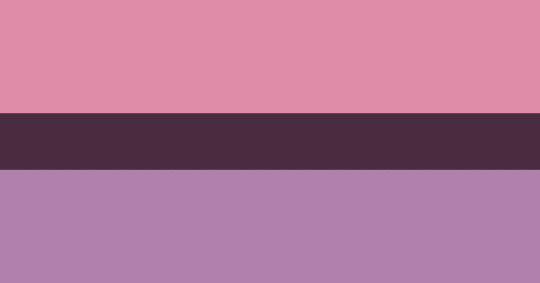
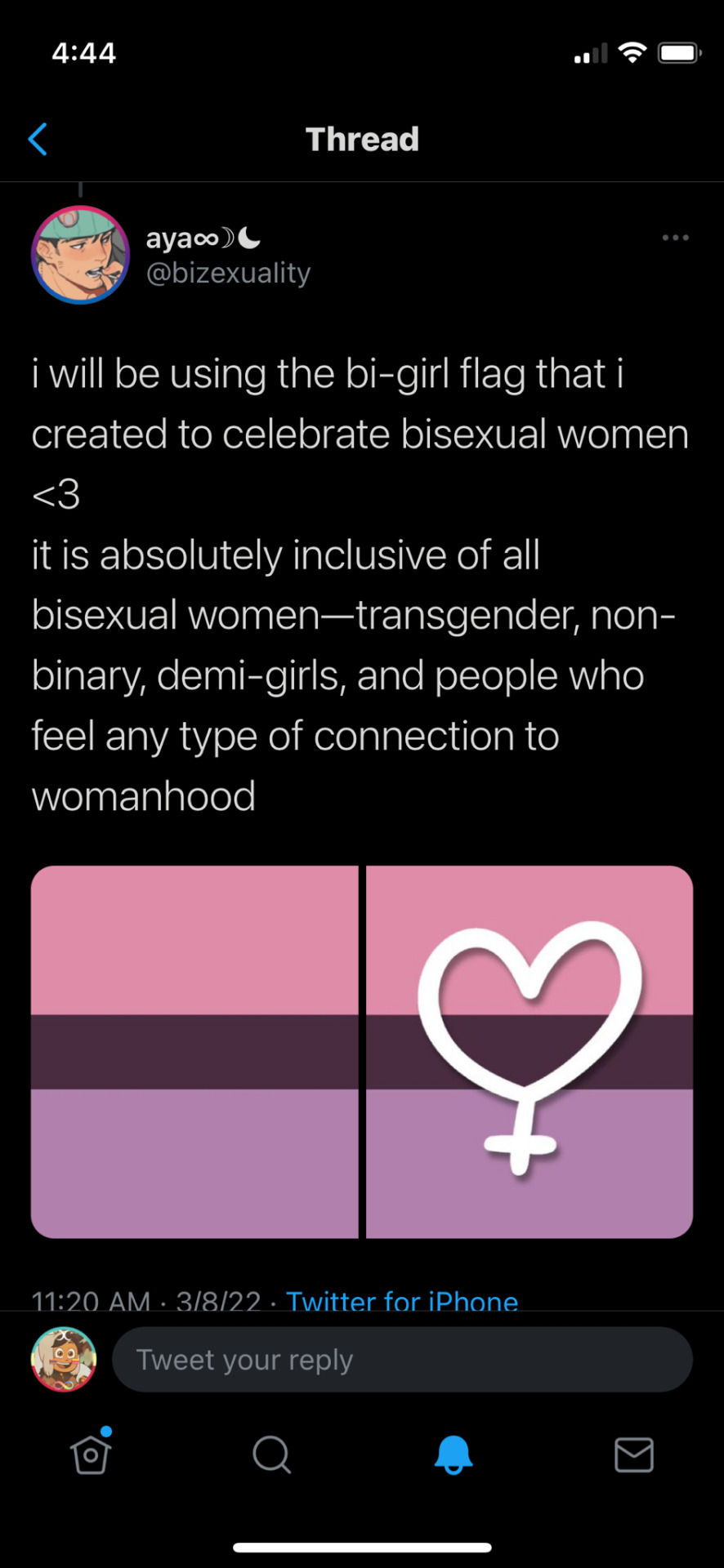


aya @/bizexuaiity's bi girl/bi woman flag!! (and their statement on the flag's creation)
[NOTE: at the time of writing this post (may 2022), aya currently uses they/them pronouns (only?). if this changes in the future, i will edit if i ever think to, but there would not be any misgendering already here.]
[ID: two identical flags and three screenshots. the flags follow the bi format, with the first 40% being a soft pink, the middle 20% being a complementary brown, and the third 40% being a desaturated lilac/lavender purple, close enough to the shade of pink to match it nicely. the first flag includes a venus symbol, which represents women, and uses a heart instead of a circle at the top. the second flag is blank without it.
the first screenshot is of @/bizexuaiity's tweet, featuring the flags, which reads: "i will be using the bi-girl flag that i created to celebrate bisexual women. <3 it is absolutely inclusive of all bisexual women - transgender, nonbinary, demigirls, and people who feel any type of connection to womanhood."
the second screenshot is of their curiouscat, and is cropped to show that part of an anonymous submission reads: "also, unrelated but i LOVE your bi girl flag!! i'm assuming you made it specifically for international women's day (march 8th)? it's so gorgeous and i plan on using it for personal stuff (all year round) if that's okay, providing credit is no issue!!"
the third screenshot shows part of their response regarding the flag, which reads: "& YES i made it for international women's day specifically & to validate bisexual women because they deserve to feel seen & visible especially because the bimisogyny they experience is utterly disgusting and i don't want them to feel ashamed for... literally being bisexual women. i'm happy that you like the flag a lot, though ;__; feel free to use it and honestly credit isn't needed unless someone specifically asks for the flag source!!" /End ID.]
^^ please tell me if there's anything i did wrong with the ID paragraph and i'll correct it ASAP. ^^
+ that anon was me btw, because of course it was!! hehe!! 💞
so as you can tell, this flag is anything but unrepresentative of my primary blog. i've used it in many icons i've made for myself since it was created 2-3 months ago and i think it's absolutely gorgeous!! it's one of those pink & purple flags that allude to womanhood nicely without feeling inherently feminine and i appreciate the design choice on that. feel free to ask me to make icons using it if you'd like and i would be more than happy to!! i can also include the symbol with them, it's really easy to do. :)
#bisexual women#bi women#bisexual girls#bi girls#bi flags#bisexual flag#bi flag#bisexual flags#bi tag#bi sapphic#bi sapphics#bi wlw#bi nblw#twitter flags#coined flags#venus symbol#♀#⚢#biphobia#bimisogyny
57 notes
·
View notes
Note
Long time viewer from way back when here! Just wanted to drop by and let you know how happy I am to see you thriving and finding your way in the world. It seems to be that in your old videos you had a deep sense of discomfort that would only go away when you were doing tons of goth-y makeup or rlly getting dressed up. Its calming in a very specific way to see photos of you now smiling in a light cardigan with your hair down.
I must be about 4-5 years younger than you, but I think I am on a very similar path. I’m starting to tease out the woman i want to be one day and your visibility and smile are helping me figure that out! It feels great to know that even tho I only feel comfortable right now in platform docs and a maid skirt (mostly joking), I have a bright future ahead full of comfort and light!
Oh gosh yeah. The further away I strode from the idea of myself as a man, allowing my true desires to come to the surface, the more insecure about my body I'd feel. Thus, going extremely hard on a look/aesthetic that could paint over those insecurities with broad strokes and also allow me a playground to push my boundaries and find out just how far I wanted to go.
I agree with you. I love that I never wear makeup now, don't obsessively shave my body, and just wear little dresses and robes and comfortable clothes. As my body started catching up to where I wanted to be as a woman, and especially after I settled into my womanhood (giving myself permission to be a woman took far too long), I started to just be comfortable. There's less and less to correct every single day.
I don't have any videos from around the time I started HRT in summer 2019. I'd moved on (though I wanted to comeback in 2020 but then COVID + I got sick derailed that plan).
The most liberating thing I experience these days is that I don't feel a need to do everything or share everything in front of an audience or online. So much of my life just belongs to me now. Growing up and coming of age with 1,000s of people watching is a trip. A hell of a ride for sure, and I'm so proud of it. But I find it so interesting to juxtapose my coming out as queer in sexuality essentially in real time on YouTube and being thrust to the forefront of a movement (as one of the only "bi guys" on YouTube at the time, which is funny given how I'm neither bi or a guy) up against my gender journey, which started privately in 2016 and became a little public in 2017/18 but then became entirely private and for me again. I think I've found it much easier to get to the truth when I'm not repackaging my insights into advice/content. It feels more like a lazy river these days as opposed to a raging rapid like it used to.
14 notes
·
View notes
Text
Disney Say Gay Pt 4
Happy Asexual Awareness Week to my fellow aces! It may not be much, but i wanted to continue my Disney Say Gay series with just a couple of potential asexual headcannons. It’s hard enough to have gay representation in Disney as it is, so to expect or for them to share any ace characters beyond the two that are confirmed - not even by the company but by the creators specifically - is unheard of. It’s not much here, but the reason i even do art now is to incorporate pride flags. So that people can see themselves and feel good, or like they’re not alone. And whatever you’re feeling right now, wherever under the ace umbrella you are, i’m here with you. I see you. And I have enough pride for all of us. This is for you guys. 💜

Mulan has been tasked with saving a damsel in distress. But, as we now, Meg may be a damsel and in distress but she can handle it. She doesn’t need some Wonderperson to come save her butt. She doesn’t get close to anyone anymore. But the longer they’re together, the more she gets to know Mulan, the more they go up against, and the more they do, Meg starts to wonder if there really is more to this Wonderperson after all. Mulan is a non-binary/genderqueer/gender nonconforming/etc icon and we all know it. But when you look at Meg, it obviously took a lot of effort for her to get close and open up to Hercules. And it was so damn hard for her to admit her feelings...she had a whole song about denying it. And we all get it; her last relationship was more traumatizing than she let on, she says she’s learned her lesson and sworn off man-handling; she can take care of herself. And she hides her emotions and vulnerability behind sass and sarcasm. It gave me major demisexual vibes, because of the time and effort and connection it took for her to really feel comfortable around Hercules and accept her feelings. And that happens to be the case with Mulan here as well. After all, there’s not technically any man-handling here....
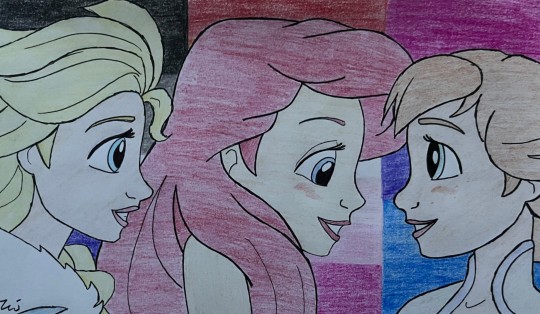
Elsa may not understand Anna’s penchant for romance, but she does want to see her sister happy more than anything. So Elsa attempts a role at matchmaker to set Anna up with Ariel. And it looks like it’s going well. Anna is definitely captivated by Ariel, though Ariel is visibly more on the nervous side. So much so that she might’ve even lost her voice! This idea was inspired by the concept of bi/lesbian/ace solidarity. Elsa obviously fits the ace vibe as a queer icon (and, come on, she’s totally ace and/or aro (although i still say she’s an aroace lesbian)). Anna, in the bi role, doesn’t care about who people are or how they identify, she likes them for who they are and always looks for the best in them regardless. Ariel as the lesbian in the picture is inspired by the queer undertones in Part of Your World; being stuck portraying someone you’re really not and you have to keep the person you really are secret. As an added bonus, the only person’s clothes we get a glimpse of is Anna’s. At first glance, you’d think the grey and purple on her jacket is a nod/support to her sister. That is, unless there’s maybe something else we don’t know about Anna yet...? While the inspiration for this drawing came from an idea of solidarity, looking at it from the perspective as an ace is also a commentary on how romance and relationships are so much at the forefront of everything; media, stories, an “ultimate goal”.... No, it’s not officially Ace Week without including a nod to my favorite ace headcannon, but she is obviously not the focus of this drawing. Like Elsa, we want to see the people we care about happy and we do have love and support for them. But the way we experience actual love or relationships or the expectations put on us is very different. No, we’re not necessarily different; at the end of the day we’re all still people. And we’ll always have our place in the community alongside our queer friends and siblings no matter what. But it’s so easy for us to feel pushed to the side or forgotten or being treated as if we don’t exist because we don’t want this “normal” things or we experience these things so differently. While there’ll never be anything wrong with who or how we love (or don’t love) or who we are, we are not less than. We’re not made up. We’re not special snowflakes. We are still here. We still exist. We still matter. And, so much like Anna does for Elsa, the people who care about us will make themselves known and want us to be just as happy as they are...though maybe without chaperoning their first dates!

On a trip through to the Human Realm, Lilith comes across this strange, stupid creature. Intrigued by it, she decided to take it back to the Demon Realm with her and raise it as her pet. The green of the jacket as well as the grey mittens are also a nod to Lilith being aromantic. It’s not so much a story with this final drawing as it is inspiration and appreciation. There didn’t need to be anything thought over or looked to with this because there was nothing to think about. Both characters have been confirmed as asexual by their creators Dana Terrace and Dan Povenmire. It feels so unheard of in Disney for asexual to even be a thing because it takes so much for them to even confirm a character might be gay or bi. Never mind anything other than cisgender on top of that. Saying a character is asexual is admitting that sexual attraction does exist (or, in our case, doesn’t) which, as a company directed at kids and families, god forbid Disney do that. It had to be confirmed out of the show and through the creators specifically. It was during Dana’s Be Gay and Do Withcraft Charity stream that we were privileged to hear a recording of Lilith herself admit she never had feelings for anyone before. To hear that coming out of the character’s mouth, for it to be confirmed that she’s aroace, made my jaw drop with excitement. She is a character i wish i could’ve had as a teenager. Or even in college. Instead of not knowing anything as a teen and, after vaguely reading something on Tumblr in college and putting off figuring out my identity for seven years, a door could’ve been opened so much sooner and i wouldn’t have spent so much time questioning. I can only imagine what she and Perry are going to do for kids and teens now. We are given this incredible character arc from Lilith and see not only how she develops friendships and grows as a person, but how meaningful the relationships she does have are and that nothing has to be romantic for happiness or accomplishments. And, as a clearly older character, Lilith proves to us that there is more after our ‘prime’ and ‘family growing’ time, that we can be successful and happy later in life. And Perry’s whole story revolves around his work and his love for Phineas and Ferb. Those kids are his family and he cares about them more than anything else. And not only does he kick butt as his job as a secret agent, he also builds a meaningful friendship with Doof in the process. Perry gives us strength and reminds us that, even if we seem ‘naive’ or ‘childlike’ not to be underestimated or looked down on because we are capable of so much. It may only be two characters and odds are we’ll be damn lucky if we can even get a glimpse of others like them. But the important thing is that they exist. They are reminders that we matter, we’re not broken, and, most of all, that we’re not alone.
🌈
I wasn’t sure if i was gonna do more of these. But i felt like i had to do something for Ace Week. This is part of who i am and i’ll never be ashamed to share that. If this helps show other aces that they’re not alone, that there’s other people like them, that we can see themselves in any characters, and that we matter; if it helps anyone questioning to see these; if there’s anyone who’s closeted or afraid or not ready to come out; that’s what these drawings are for. And i hope that one day, it won’t just be us hoping or self-projecting or nit-picking. That these headcannons can be more than just headcannons. We and multiple characters will be able to say We’re Here and We’re Queer.... Or, in this weeks’ case, We’re Here and We’re Ace 😆 Parts one, two, and three.
#asexual awareness week#disney say ace#fanart#drawing#megara#hercules#demisexual#mulan#nonbinary#elsa#asexual#anna#bisexual#bi#ariel#the little mermaid#lesbian#gay#lilith#lilith clawthorne#the owl house#toh#perry#perry the platypus#phineas and ferb#ace#disney say gay#lgbt#lgbtq#lgbtqia
13 notes
·
View notes